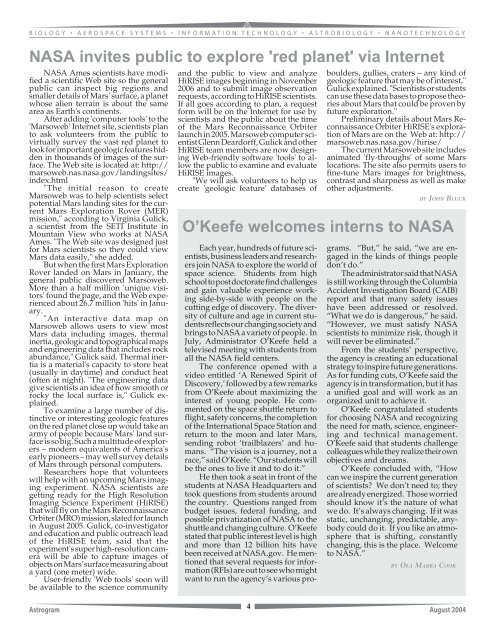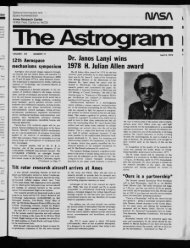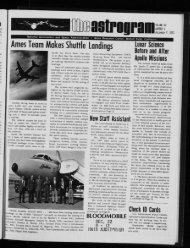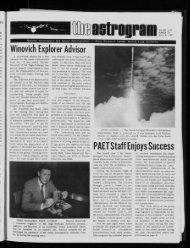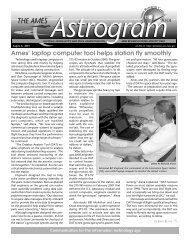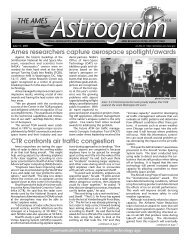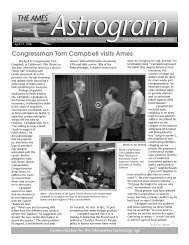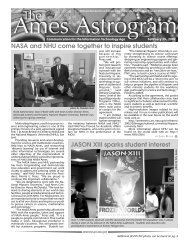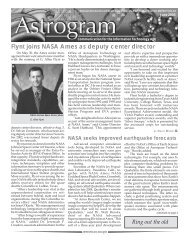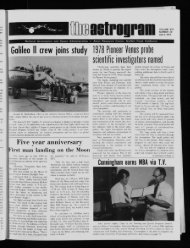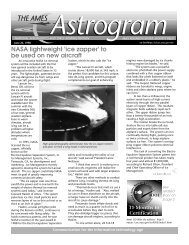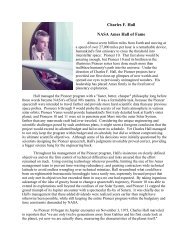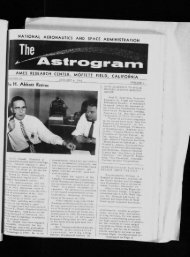Innovative partnership to revolutionize NASA supercomputing
Innovative partnership to revolutionize NASA supercomputing
Innovative partnership to revolutionize NASA supercomputing
You also want an ePaper? Increase the reach of your titles
YUMPU automatically turns print PDFs into web optimized ePapers that Google loves.
<strong>NASA</strong> invites public <strong>to</strong> explore 'red planet' via Internet<br />
<strong>NASA</strong> Ames scientists have modified<br />
a scientific Web site so the general<br />
public can inspect big regions and<br />
smaller details of Mars' surface, a planet<br />
whose alien terrain is about the same<br />
area as Earth's continents.<br />
After adding 'computer <strong>to</strong>ols' <strong>to</strong> the<br />
'Marsoweb' Internet site, scientists plan<br />
<strong>to</strong> ask volunteers from the public <strong>to</strong><br />
virtually survey the vast red planet <strong>to</strong><br />
look for important geologic features hidden<br />
in thousands of images of the surface.<br />
The Web site is located at: http://<br />
marsoweb.nas.nasa.gov/landingsites/<br />
index.html<br />
"The initial reason <strong>to</strong> create<br />
Marsoweb was <strong>to</strong> help scientists select<br />
potential Mars landing sites for the current<br />
Mars Exploration Rover (MER)<br />
mission," according <strong>to</strong> Virginia Gulick,<br />
a scientist from the SETI Institute in<br />
Mountain View who works at <strong>NASA</strong><br />
Ames. "The Web site was designed just<br />
for Mars scientists so they could view<br />
Mars data easily," she added.<br />
But when the first Mars Exploration<br />
Rover landed on Mars in January, the<br />
general public discovered Marsoweb.<br />
More than a half million 'unique visi<strong>to</strong>rs'<br />
found the page, and the Web experienced<br />
about 26.7 million 'hits' in January.<br />
"An interactive data map on<br />
Marsoweb allows users <strong>to</strong> view most<br />
Mars data including images, thermal<br />
inertia, geologic and <strong>to</strong>pographical maps<br />
and engineering data that includes rock<br />
abundance," Gulick said. Thermal inertia<br />
is a material's capacity <strong>to</strong> s<strong>to</strong>re heat<br />
(usually in daytime) and conduct heat<br />
(often at night). "The engineering data<br />
give scientists an idea of how smooth or<br />
rocky the local surface is," Gulick explained.<br />
To examine a large number of distinctive<br />
or interesting geologic features<br />
on the red planet close up would take an<br />
army of people because Mars' land surface<br />
is so big. Such a multitude of explorers<br />
– modern equivalents of America's<br />
early pioneers – may well survey details<br />
of Mars through personal computers.<br />
Researchers hope that volunteers<br />
will help with an upcoming Mars imaging<br />
experiment. <strong>NASA</strong> scientists are<br />
getting ready for the High Resolution<br />
Imaging Science Experiment (HiRISE)<br />
that will fly on the Mars Reconnaissance<br />
Orbiter (MRO) mission, slated for launch<br />
in August 2005. Gulick, co-investiga<strong>to</strong>r<br />
and education and public outreach lead<br />
of the HiRISE team, said that the<br />
experiment's super high-resolution camera<br />
will be able <strong>to</strong> capture images of<br />
objects on Mars' surface measuring about<br />
a yard (one meter) wide.<br />
User-friendly 'Web <strong>to</strong>ols' soon will<br />
be available <strong>to</strong> the science community<br />
and the public <strong>to</strong> view and analyze<br />
HiRISE images beginning in November<br />
2006 and <strong>to</strong> submit image observation<br />
requests, according <strong>to</strong> HiRISE scientists.<br />
If all goes according <strong>to</strong> plan, a request<br />
form will be on the Internet for use by<br />
scientists and the public about the time<br />
of the Mars Reconnaissance Orbiter<br />
launch in 2005. Marsoweb computer scientist<br />
Glenn Deardorff, Gulick and other<br />
HiRISE team members are now designing<br />
Web-friendly software '<strong>to</strong>ols' <strong>to</strong> allow<br />
the public <strong>to</strong> examine and evaluate<br />
HiRISE images.<br />
"We will ask volunteers <strong>to</strong> help us<br />
create 'geologic feature' databases of<br />
Each year, hundreds of future scientists,<br />
business leaders and researchers<br />
join <strong>NASA</strong> <strong>to</strong> explore the world of<br />
space science. Students from high<br />
school <strong>to</strong> post doc<strong>to</strong>rate find challenges<br />
and gain valuable experience working<br />
side-by-side with people on the<br />
cutting edge of discovery. The diversity<br />
of culture and age in current students<br />
reflects our changing society and<br />
brings <strong>to</strong> <strong>NASA</strong> a variety of people. In<br />
July, Administra<strong>to</strong>r O’Keefe held a<br />
televised meeting with students from<br />
all the <strong>NASA</strong> field centers.<br />
The conference opened with a<br />
video entitled ‘A Renewed Spirit of<br />
Discovery,’ followed by a few remarks<br />
from O’Keefe about maximizing the<br />
interest of young people. He commented<br />
on the space shuttle return <strong>to</strong><br />
flight, safety concerns, the completion<br />
of the International Space Station and<br />
return <strong>to</strong> the moon and later Mars,<br />
sending robot ‘trailblazers’ and humans.<br />
“The vision is a journey, not a<br />
race,” said O’Keefe. “Our students will<br />
be the ones <strong>to</strong> live it and <strong>to</strong> do it.”<br />
He then <strong>to</strong>ok a seat in front of the<br />
students at <strong>NASA</strong> Headquarters and<br />
<strong>to</strong>ok questions from students around<br />
the country. Questions ranged from<br />
budget issues, federal funding, and<br />
possible privatization of <strong>NASA</strong> <strong>to</strong> the<br />
shuttle and changing culture. O’Keefe<br />
stated that public interest level is high<br />
and more than 12 billion hits have<br />
been received at <strong>NASA</strong>.gov. He mentioned<br />
that several requests for information<br />
(RFIs) are out <strong>to</strong> see who might<br />
want <strong>to</strong> run the agency’s various pro-<br />
boulders, gullies, craters – any kind of<br />
geologic feature that may be of interest,"<br />
Gulick explained. "Scientists or students<br />
can use these data bases <strong>to</strong> propose theories<br />
about Mars that could be proven by<br />
future exploration."<br />
Preliminary details about Mars Reconnaissance<br />
Orbiter HiRISE's exploration<br />
of Mars are on the Web at: http://<br />
marsoweb.nas.nasa.gov/hirise/<br />
The current Marsoweb site includes<br />
animated 'fly-throughs' of some Mars<br />
locations. The site also permits users <strong>to</strong><br />
fine-tune Mars images for brightness,<br />
contrast and sharpness as well as make<br />
other adjustments.<br />
BY JOHN BLUCK<br />
O’Keefe welcomes interns <strong>to</strong> <strong>NASA</strong><br />
grams. “But,” he said, “we are engaged<br />
in the kinds of things people<br />
don’t do.”<br />
The administra<strong>to</strong>r said that <strong>NASA</strong><br />
is still working through the Columbia<br />
Accident Investigation Board (CAIB)<br />
report and that many safety issues<br />
have been addressed or resolved.<br />
“What we do is dangerous,” he said.<br />
“However, we must satisfy <strong>NASA</strong><br />
scientists <strong>to</strong> minimize risk, though it<br />
will never be eliminated.”<br />
From the students’ perspective,<br />
the agency is creating an educational<br />
strategy <strong>to</strong> inspire future generations.<br />
As for funding cuts, O’Keefe said the<br />
agency is in transformation, but it has<br />
a unified goal and will work as an<br />
organized unit <strong>to</strong> achieve it.<br />
O’Keefe congratulated students<br />
for choosing <strong>NASA</strong> and recognizing<br />
the need for math, science, engineering<br />
and technical management.<br />
O’Keefe said that students challenge<br />
colleagues while they realize their own<br />
objectives and dreams.<br />
O’Keefe concluded with, “How<br />
can we inspire the current generation<br />
of scientists? We don’t need <strong>to</strong>; they<br />
are already energized. Those worried<br />
should know it’s the nature of what<br />
we do. It’s always changing. If it was<br />
static, unchanging, predictable, anybody<br />
could do it. If you like an atmosphere<br />
that is shifting, constantly<br />
changing, this is the place. Welcome<br />
<strong>to</strong> <strong>NASA</strong>.”<br />
BY OLA MARRA COOK<br />
Astrogram<br />
4<br />
August 2004



